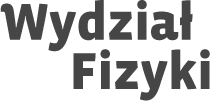- Dla kandydatów
- Dla studentów
- Informacje dla studentów I roku
- Informacje ogólne
- Informator o studiach
- Organizacja roku
- Zarządzenia Prodziekana ds. studenckich
- Kolokwia i egzaminy
- Prace i egzaminy dyplomowe
- Materiały dydaktyczne
- Pracownie
- Pracownia Projektów Studenckich
- Zespołowe projekty studenckie
- Oprogramowanie
- Konta i hasła w sieci studenckiej
- Studia doktoranckie
- Studia podyplomowe
- Samorząd, koła, kluby, chór
- Stypendia i sprawy socjalne
- Oferty pracy
- Dla pracowników
- Dla gości
- Badania
- Wydział
- Misja i strategia
- Władze Wydziału
- Zarządzenia Dziekana
- Zarządzenia Prodziekana ds. studenckich
- Struktura organizacyjna
- Historia Wydziału
- 90 lat Wydziału Fizyki
- 100 lat Wydziału Fizyki
- Fizykoteka – Wirtualne Muzeum Wydziału Fizyki UW
- Dziekanat
- Rada Wydziału
- Jakość kształcenia
- Stopnie i tytuły naukowe
- Nagrody Wydziału Fizyki
- Biblioteka
- Ośrodek Komputerowy
- Pracownicy i doktoranci
- Zamówienia publiczne
- Rezerwacja i wynajem sal
- Oferty pracy
- Osoby
- Zapraszamy
- Media
Konwersatorium im. Jerzego Pniewskiego i Leopolda Infelda
2024-10-28
W poniedziałek 28 października 2024 r. o godz 11.00 w sali 0.06 odbędzie się pierwsze w tym roku akademickim Konwersatorium im. Jerzego Pniewskiego i Leopolda Infelda Wydziału Fizyki UW.
Wykład zatytułowany
"Nuclear chirality: from curiosity to mainstream research"
wygłosi
dr hab. Ernest Grodner (Narodowe Centrum Badań Jądrowych, Warszawa).
Lord Kelvin stwierdził w 1904 r.: “I call any geometrical figure, or group of points, chiral, and say it has chirality if its image in a plane mirror, ideally realized, cannot be brought to coincide by itself.” Chiralność jest zjawiskiem obecnym w różnych układach fizycznych i w szerokim zakresie skal wielkości. Podczas wykładu usłyszymy o zjawiskach obserwowanych w badaniach jąder atomowych, które można interpretować jako chiralne.
Wykład odbędzie się w języku angielskim.
Przed Konwersatorium, od godz. 10.30, zapraszamy na nieformalne dyskusje przy kawie i ciastkach w holu przed salą 0.06.
Kolejne Konwersatorium odbędzie się 25.XI.2024 r. i będzie poświęcone tegorocznej Nagrodzie Nobla w dziedzinie fizyki.
Barbara Badełek
Jan Chwedeńczuk
Jan Kalinowski
Jan Suffczyński
Abstract:
Two decades ago the existence of the nuclear chirality phenomenon was experimentally confirmed for the first time thanks to the cooperation of two Warsaw University units, i.e. the Faculty of Physics and the Heavy Ion Laboratory. Among various types of chirality in science, the nuclear one deals with low energy collective nuclear excitations. Initially, the nuclear chirality research covered only a few strictly characteristic isotopes and was considered an interesting curiosity with a significant degree of risk. The next two decades were characterized by a rapid development of nuclear chirality study, both theoretical and experimental. Numerous chiral-characteristic signatures and phenomena have been predicted and observed. Not only has the range of isotopes (over 60 today) recognized as chiral expanded from odd-odd through odd-even up to even-even nuclei but also the number of chiral structures in excitation level schemes in single nuclei has been multiplied. Today, in some isotopes a set of chiral excited states is comparable to the set of other excited states in the same energy range. The chirality effect from a niche topic grew up to the mainstream of nuclear spectroscopy. National Centre for Nuclear Research in cooperation with Heavy Ion Laboratory remains at the forefront of chirality research actively setting the direction of further study.






